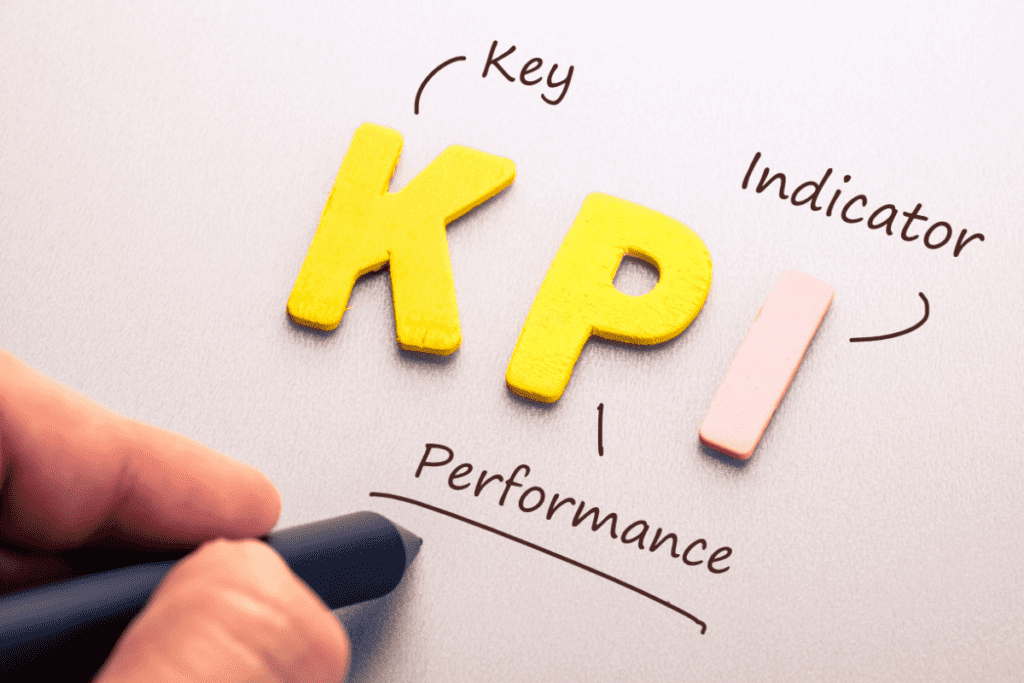Important Project KPIs: The Project Management KPI List
Are you having trouble keeping track of your project’s progress? It’s a common dilemma many project professionals face. This blog introduces the core project management KPI list. This curated list of core Key Performance Indicators (KPIs) will help measure the efficiency and effectiveness of your projects.
By acquainting yourself with these handpicked KPIs, you’ll equip yourself to better navigate the success path for every project. Get ready as we delve into uncovering these powerful tools!
Key Takeaways
- Project Management KPIs are essential metrics that measure a project’s success and progress.
- There are four main types of KPIs in project management: timeliness, quality, cost, and stakeholder satisfaction. Each type helps monitor different aspects of a project.
- Earned Value Metrics: Planned Value (PV), Actual Cost (AC), Earned Value (EV), Return on Investment (ROI), Cost Variance (CV), Schedule Variance (SV).
- Following best practices such as setting SMART goals, using accurate data, and regularly monitoring the chosen KPIs can contribute to the success of projects.
Understanding Project Management KPIs

Project Management KPIs are essential metrics used to measure the success and progress of a project.
Definition and importance of KPIs in project management
KPIs, short for key performance indicators, are tools used in project management. They tell us if a project is doing well or not. To do this, they measure parts of the project that matter most to its success.
Each KPI is like a health check-up on the project’s progress. They give the team facts and figures about how things are going. This helps them make smart choices and keeps them from making mistakes.
Without KPIs, it would be hard to know if a project is on track or off course until it’s too late.
Types of KPIs in project management
Project managers use different types of KPIs to manage a project. These KPIs help them keep track of the project’s progress and success. Below are four main types of KPIs used in project management.
- Timeliness KPIs: These KPIs look at how well the team is sticking to the schedule. They measure if tasks are done on time and if the project will wrap up within its timeline.
- Quality KPIs: Project managers use these KPIs to check on the work quality. They watch for things like how happy customers are with a project’s outcome or if any mistakes were made during working on tasks.
- Cost KPIs: These types of KPIs help to know how well money is spent on a project. Project managers often compare budget plans with the actual cost to see if they are spending too much or just enough.
- Stakeholder Satisfaction KPIs: These are used to know how content stakeholders are with a project’s progress and outcomes. It could be about clients who have invested in projects or team members who help carry out tasks for a project.
 Key Project Management KPIs
Key Project Management KPIs
Planned Value (PV), Actual Cost (AC), and Earned Value (EV) are three important project management KPIs that help measure the progress and performance of a project. They are the foundational pillars of the Earned Value Management (EVM) graph.
This EVM is a visual representation that encapsulates a project’s financial performance and progress, serving as an invaluable tool for project managers.
Its ability to compare budgeted costs against actual expenditures and the real value of completed work make it a cornerstone project metric.
Many project managers liken the EVM graph to a ‘crystal ball’ that offers foresight into project success.
Planned Value (PV)
Planned Value (PV) is a key tool for project managers. It tells you the cost of all work that should have been done by now. This helps to track your project budget and see how well you are sticking to it.
To get PV, multiply the total budget by the percentage of work planned to be done at this time. With PV, you can see if your spending matches what was laid out in the cost plan.
Actual Cost (AC)
Actual Cost (AC) is a measure of the money spent on the work performed in a project. It includes things like employee salaries, benefits, office space, equipment, and other expenses related to the project.
By tracking AC, project managers can understand how well the project is performing financially and if it’s staying within budget. To calculate AC, you add up all the actual costs incurred for activities and tasks in the project.
This metric is important because it helps assess progress and identify any cost overruns or financial risks.
Earned Value (EV)
Earned Value (EV) is an important metric in project management that helps measure the progress and performance of a project. It tells us how much value or work has been completed so far.
To calculate EV, we multiply the total budget for the project by the percentage of completion. For example, if a project is 50% complete and has a budget of $100,000, the earned value would be $50,000.
EVM (Earned Value Management) uses EV as a key performance indicator to track and control projects effectively. By analyzing earned value data, project managers can gain insights into whether a project is on track or falling behind schedule and budget.
This information allows them to take corrective actions early on to ensure successful project completion.
Return on Investment (ROI)
Return on Investment (ROI) is an essential Key Performance Indicator (KPI) in project management. It helps project managers determine whether a project is profitable or not and by how much.
ROI measures the financial gains or losses generated by a project. By calculating ROI, you can assess the value of your project investment and make informed decisions. This KPI enables project management leaders to gauge and maximize return on their investments, ensuring that projects are financially successful.
Cost Variance (CV)
Cost Variance (CV) is a project management key performance indicator that measures the difference between the planned budget and the actual cost of a project. It helps determine if the project cost is above or below what was originally planned.
A positive CV means the project is under budget, while a negative CV indicates it is over budget. Tracking and managing CV allows project managers to effectively control costs throughout the project’s lifecycle.
CV can be calculated for the entire project or for specific phases or tasks within the project.
Cost Performance Index (CPI)
The Cost Performance Index (CPI) is a measure that compares the budgeted cost of the work accomplished to the actual amount spent. It helps project managers assess how efficiently they are using project expenses.
To calculate CPI, divide the Earned Value (EV) by the Actual Cost (AC). If your CPI is greater than 1, it means your project is performing well within budget. However, if your CPI is less than 1, it suggests that you are over budget and need to make adjustments.
Keeping track of CPI can help you stay on top of your project’s financial performance.
Schedule Variance (SV)
Schedule Variance (SV) is an important Key Performance Indicator (KPI) in project management. It helps project managers assess whether their projects schedule is on track or not. SV is calculated by subtracting the planned value (PV), which represents how much work was scheduled to be done at a certain point, from the earned value (EV), which represents how much work has actually been completed.
A positive SV means that the project is ahead of schedule, while a negative SV indicates that it’s behind schedule. By comparing EV and PV, project managers can identify potential delays or inefficiencies in project execution.
SV is often used alongside other KPIs like cost variance (CV) and schedule performance index (SPI) to get a comprehensive view of project performance.
Schedule Performance Index (SPI)
The Schedule Performance Index (SPI) is a project management KPI that compares the earned value, which measures progress, to the planned value, which represents what was expected. It helps project professionals and new managers assess whether the project is on schedule or falling behind.
To calculate SPI, divide the earned value by the planned value. If the result is greater than 1, it means the project is ahead of schedule. This metric provides valuable insights into a project’s progress and helps ensure timely completion.
Resource utilization
Resource utilization is an important KPI in project management. It measures how effectively team members’ time is used while working on a project. This KPI reflects the efficiency of project resources for billable work and helps project managers assess the productivity and efficiency of their team members.
Project managers track resource utilization to identify areas for improvement, optimize resource allocation, and ensure smooth project operations. Resource utilization KPIs are essential for measuring project performance and success.
Percentage of tasks completed
The percentage of tasks completed is a valuable metric in project management. It helps project managers understand how much progress has been made towards completing the project. By tracking this KPI, project managers can effectively allocate resources and identify if additional team members need to be hired.
This metric also assists in setting accurate timelines for when the project will be finished. Overall, the percentage of tasks completed provides important insights into the performance of the entire project.
Percentage of projects completed on time
The percentage of projects completed on time is a very important Key Project Management KPI. It tells us how many projects are being finished within their scheduled timeframe. This information helps project managers allocate resources properly and determine if they need to hire more people.
By tracking this KPI, project managers can also set accurate timelines for completing future projects. It’s worth noting that around 54% of organizations don’t effectively track their KPIs in real-time. This makes it harder to keep projects on track and ensure they are completed on time.
So, keeping an eye on the project completion rate is crucial for project managers to stay organized and successful in their work.
Best Practices for Defining and Using Project Management KPIs
To ensure effective use of project management KPIs, it is important to follow best practices such as setting SMART goals, using accurate and relevant data, ensuring KPIs are actionable and achievable, and regularly monitoring and tracking them.
SMART goal setting for KPIs
SMART goal setting is important when defining KPIs for project management. It helps ensure that the goals are specific, measurable, attainable, relevant, and time-bound.
- Be specific about what each KPI will measure and why it is important.
- Make sure the KPIs can be measured to a defined standard.
- Ensure that the goals are attainable and realistic within the project context.
- Keep the goals relevant to the overall objectives of the project.
- Set a clear timeline for achieving the goals and make them time-bound.
Using accurate and relevant data
Accurate and relevant data plays a crucial role in measuring and tracking project management KPIs. By using reliable information, project professionals and new project managers can make informed decisions about the progress of their projects.
This data helps them identify if the project is on track or if adjustments need to be made. For example, by monitoring budget adherence and stakeholder satisfaction with accurate data, they can ensure that resources are allocated effectively and stakeholders’ needs are met.
With the right data at hand, project managers can take proactive steps to keep their projects on schedule, within budget, and deliver successful outcomes.
Ensuring KPIs are actionable and achievable
To ensure that KPIs in project management are actionable and achievable, it is important to follow some best practices. Firstly, the KPIs should be specific and clearly defined, so that they can guide the actions of the project team.
Secondly, they need to be realistic and attainable within the given resources and constraints. It’s also essential that the KPIs are measurable, so progress can be tracked objectively.
Additionally, setting a timeframe for achieving these goals will help with accountability and keep everyone focused on meeting deadlines. Finally, regularly monitoring and tracking the KPIs will ensure timely adjustments can be made if needed for successful project outcomes.
Monitoring and tracking KPIs regularly
Monitoring and tracking KPIs regularly is crucial for project professionals and new project managers. It helps in keeping a project on track and identifying areas for improvement. Here are some important points to remember:
- Regular monitoring and tracking of KPIs allows you to stay updated on the progress of your project.
- It helps you identify if the project is meeting its targets and objectives.
- By tracking KPIs, you gather valuable data to make informed decisions and take corrective actions when necessary.
- By regularly monitoring KPIs, you can identify any issues or bottlenecks early on and address them promptly.
- It helps in evaluating the effectiveness of your project strategies and making adjustments as needed.
- Regular tracking of KPIs provides visibility into the overall performance of your project, allowing you to communicate progress to stakeholders effectively.
FAQs
1. What is a KPI in project management?
A KPI, or Key Performance Indicator, in project management is a measurable value that helps track the progress and success of a project.
2. How do I choose the right KPIs for my project?
To choose the right KPIs for your project, identify the specific goals and objectives of your project, and then select metrics that align with those goals and reflect key areas of performance.
3. What are some commonly used KPIs in project management?
Some commonly used KPIs in project management include budget variance (the difference between planned and actual costs), schedule adherence (meeting deadlines), and quality assurance (measuring defects or errors).
4. How can tracking KPIs benefit my project?
Tracking KPIs can provide valuable insights into the progress of your project, help identify areas that need improvement or attention, and support informed decision-making to ensure successful outcomes.
Conclusion
In conclusion, project management KPIs are important tools that help track and measure a project’s performance. By using clear and focused KPIs, project managers can better monitor the health of their projects and identify areas for improvement.
Understanding and utilizing these KPIs can greatly contribute to the success of projects. So, make sure to choose the right KPIs for your project and regularly track them to ensure its success.
If you liked this article, remember to subscribe to MiamiCloud.com. Connect. Learn. Innovate.







